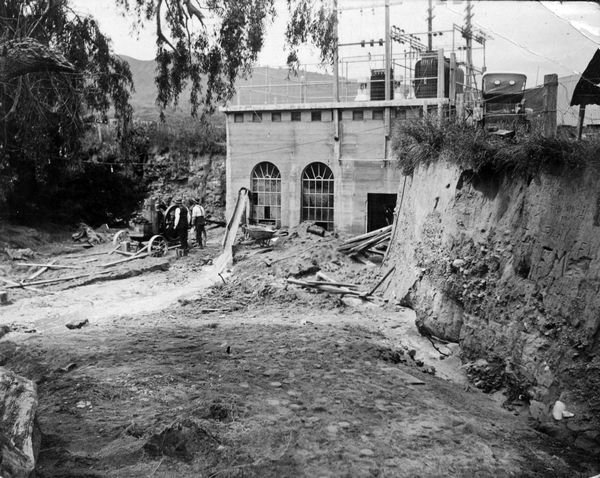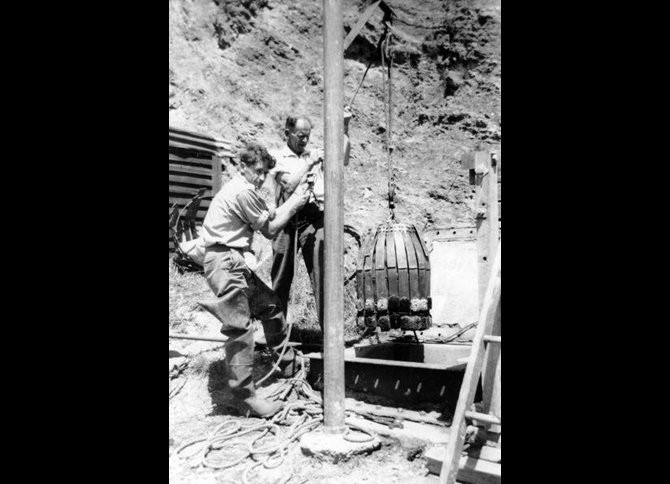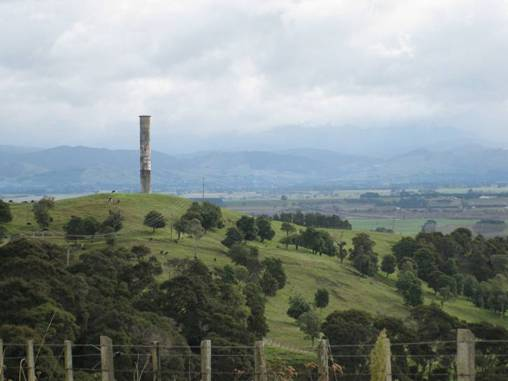The Kourarau Power Stations, also known as the Kourarau Hydro-electric Power Scheme, were first established in 1923 by the Wairarapa Electric Power Board. The first publicly owned hydro-electric power scheme in the Wairarapa, the stations continue to operate today on their original machinery.

Kourarau Power Station, 1924. Workers repair the Kourarau Power Station following a major flood in 1924. Wairarapa Archives ref: 00-247/1a. http://masterton.spydus.co.nz/cgi-bin/spydus.exe/ENQ/OPAC/ARCENQ?RNI=523636
Development of the scheme
In pursuit of renewable energy, the Wairarapa Electric Power Board, later part of Wairarapa Electricity Ltd., selected the Kourarau Stream, near Gladstone, as the site for a local hydro-electric power scheme. The scheme was designed by Harry Richard Climie (1884-1961), an established engineer who designed six other hydro-electric power schemes during his career. The scheme was backed by prominent locals, namely Sir Walter Buchanan (1838-1924), on whose land the stations were built.
Work began in 1920. The first station, Station A, or the Lower Station, was opened in 1923 and was soon followed by Station B, or the Upper Station, two years later. At the time of Station A’s completion, the electricity generated was sufficient to power the entire district, covering household, commercial, and dairying needs. The Kourarau Stations were only ever intended as a temporary scheme until the completion of the Mangahao Power Station in 1924. The stations were primarily a standby source for peak hours and emergencies until 1930, when an agreement was reached to feed power from Kourarau back into the national grid.
In 1999, the stations were acquired by Genesis Energy Ltd. In 2005, flood damage put the scheme’s future at risk. Years of negotiation followed before the stations were taken over in 2011 by community-owned enterprise, Trust House Ltd. Today, the site is increasingly used recreationally. The upper lake is a well-known trout fishing spot which is open throughout the year.
Streams, Stations and Storms
The 219-metre drop of the Kourarau Stream, which is fed by artesian springs at its head, endeared it to the Wairarapa Hydro-Electric Investigations Committee of 1916, which investigated the potential of five other rivers in the region before choosing to develop the Kourarau site.
Station A utilises a 131-metre drop and is notable for its diversion dam, a 0.78-metre diameter concrete pipeline, and two 0.53-metre diameter steel pipelines. These pipelines supply a Boving twin-disc Pelton wheel turbine, driving a General Electric 700-kilowatt generator. A surge tower is located near the head of these pipelines. The powerhouse discharges into the lower reach of the Kourarau Stream just before it merges with the Waingongoro Stream, a tributary of the Ruamahanga River.
Station B makes use of a further 88-metre fall and includes a dam, a tunnel through the ridge, a second surge tower, and a 0.61-metre diameter steel pipeline, ending at a powerhouse at the diversion lake. In the powerhouse, a Boving single-disc Pelton wheel turbine drives an ASEA 250-kilowatt generator. The stations have been significantly damaged by flooding twice in their lifetime, yet have endured many storms, and withstood the 1942 Wairarapa earthquakes.

Workers put the 'hedgehog', used for cleaning pipes at the Kourarau Power Station, into a pipe. Wairarapa Archives ref: 00-247/2d. http://masterton.spydus.co.nz/cgi-bin/spydus.exe/ENQ/OPAC/ARCENQ?RNI=529285
Tupurupuru and the Taniwha
The land around the Kourarau Power Stations is culturally significant to the Rangitāne and Ngāti Kahungunu iwi of the Wairarapa. The area is central to the story of Tupurupuru, then a young warrior, who saved the life of his love, Konini, and slew the taniwha Ngarara Huarau, who was terrorising local settlements. Ngarara Huarau made his lair at the head of the Kourarau Stream. ‘Kourarau’ means ‘many kōura’, or crayfish. The Kourarau Stream is fed by a limestone spring, maintaining a steady flow throughout the year, which results in ideal conditions for the freshwater crustaceans. The interiors of the pipes need to be cleared of lime deposit periodically; this is done using a device known as the ‘hedgehog’.

View of surge tower, Station A. Engineering New Zealand.
More Information
Heritage Recognition
The Kourarau Power Stations are recognised by Heritage New Zealand Pouhere Taonga as a Category 2 Historic Place (list no. 7814). Go to www.heritage.org.nz/the-list/details/7814
Further reading
Heritage New Zealand Pouhere Taonga. “Kourarau Hydroelectric Power Scheme”. www.heritage.org.nz/the-list/details/7814
Rennie, Neil. 1989. Power to the People: 100 Years of Public Electricity Supply in New Zealand. Wellington, New Zealand: Electricity Supply Association of New Zealand.
Saunders, T. V. 1972. “Tupurupuru: An Old Maungaraki Māori Love Story”. Te Ao Hou, No. 70, p.12-14. teaohou.natlib.govt.nz/journals/teaohou/issue/Mao70TeA/c5.html
Trust House. “Kourarau Hydroelectric Power Scheme”. trusthouse.co.nz/wp-content/uploads/2015/08/Kourarau.pdf
Access
The Kourarau Power Stations are not currently open to the public.
Location
Kourarau power Stations
